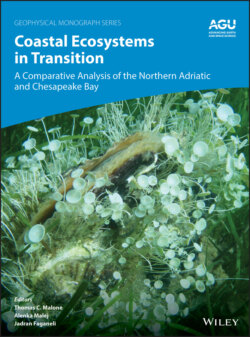Читать книгу Coastal Ecosystems in Transition - Группа авторов - Страница 18
1.2.3. Effects of Nutrient Enrichment 1.2.3.1. Phytoplankton Production
ОглавлениеAnnual cycles and interannual variability of phytoplankton biomass and primary productivity in CB and the NAS are driven by variations in riverine inputs of buoyancy and nutrients. Differences in circulation patterns and geomorphology are reflected in contrasting patterns and levels of eutrophication. Despite having a much lower annual nutrient load than the NAS, annual phytoplankton production is five times higher in CB than in the NAS. Chesapeake Bay is eutrophic system‐wide while eutrophication in the NAS is confined to the western NAS, which is directly influenced by the Po River. Receiving waters of CB effectively sequester riverborne nutrient inputs into phytoplankton biomass, and efficiently retain and recycle phytoplankton biomass produced in spring (dominated by diatoms) to support high primary productivity during summer. The seasonal accumulation of biomass during spring also fuels the annual occurrence of extensive bottom‐water oxygen depletion during summer in CB. In contrast, seasonal increases in phytoplankton biomass and primary productivity are much lower in the NAS, and bottom‐water oxygen depletion is more sporadic in time and space—patterns that reflect the rapid dilution of riverborne nutrient inputs in the NAS. Dinoflagellate blooms occur most frequently under stratified conditions in both systems. However, in contrast to CB, the formation of large organic aggregates in the NAS (“mare sporco”) during some years displaces the normally frequent dinoflagellate blooms of the summer.
Since 1729, mare sporco following the spring diatom bloom occurred relatively infrequently (1729, 1872, 1880, 1903, 1930, 1949) compared with the late 1970s through the 1990s (1976, 1983, 1988, 1989, 1991, and 1997), perhaps as a consequence of nutrient enrichment, i.e., they tend to occur under high phytoplankton production, fueled by Po River nutrient inputs during spring and summer, leading to the formation of mucus mats that are transported eastward resulting in episodic deposition of POM and the development of isolated patches of bottom‐water anoxia. The location of these mass mortalities varies throughout the season and from year to year, but their cumulative impact results in widespread benthic mortalities in the NAS.
